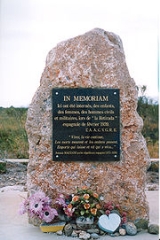
Camp de Rivesaltes
Encyclopedia
The Camp de Rivesaltes is a military camp in France (also called camp Joffre
) located on the territory of the commune of Rivesaltes
in Pyrénées-Orientales
in the South of France
. The camp was also used for interning several civil populations during 1939–2007. The darkest period of the camp was in 1942 when 2,251 Jews
, including 110 children, were transferred from Rivesaltes via the Drancy internment camp
to Auschwitz
, where they were murdered.
, situated on a rail route and 40 km from the Spanish border, was considered a strategic position for the French Army
. 5 km from the city of Rivesaltes
, the army
occupied 612 hectares between Rivesaltes
and Salses, to construct a camp, originally intended as a military base.
At the same time, southern France became a major haven for Jewish refugees attempting to flee to neutral countries, whether legally or illegally.
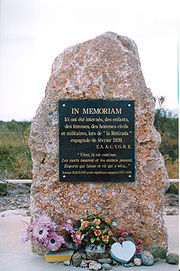
; four-fifths of the camp was situated within the commune of Rivesaltes
and one-fifth within the commune of Salses.
Following the Retirada
, the government decided to use Camp Joffre to intern more than 15,000 Catalan refugees. This decision remained in the planning stages, though a small influx of Catalan refugees was brought in (1939).
On the December 10, 1940, the Ministry of Defense set aside 600 acres (2.4 km²) south of the camp, to house individuals expelled from Germany
. The military camp was then run parallel to the civilian camps.
In 1939, at the start of the second world war, the camp became a military transit base and in 1940 a refuge for Spanish refugees
fleeing the Franco dictatorship
. After the signing of the armistice
, France
was split into two. The zone libre, in which the Pyrenees-Orientales
was included, came under the administration of the Vichy government.
Gradually, the Joffre camp became a place of internment for families of gypsies, Jews
and Spanish refugees
. With a capacity of 8000, it was not long before the camp was overcrowded, families were separated, and conditions deteriorated greatly.
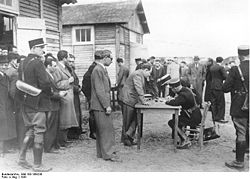 When the first internees arrived on January 14, 1941, the status of the camp was not yet fixed.
When the first internees arrived on January 14, 1941, the status of the camp was not yet fixed.
It was decided that this is a "accommodation center" for families. Initially planned for a maximum of 17,000 "guests", it included 150 large barracks, adding up to a housing capacity of 10,000 individuals.
The particularity of the place was that families were housed in the same camp, but in separate barracks: there were barracks for men, others for women and children. By May 31, 1941, the camp had 6,475 internees from 16 nationalities, more than half from Spain
. Jewish refugees from other countries made up more than one-third.
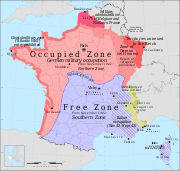
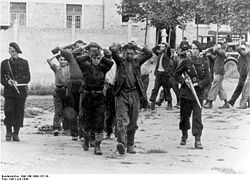 On August 26, 1942, at five o'clock in the morning, an operation began: a round-up of foreign Jews
On August 26, 1942, at five o'clock in the morning, an operation began: a round-up of foreign Jews
in the southern zone. They were brought to the 'Centre national de rassemblement des Israélites' at Rivesaltes
. This "Center" was newly established in the camp, in blocks J (for women and children), F (for men; this block had previously been reserved for workers) and K (reception, screening and sorting). It was planned as a transit camp for a total of 10,000 internees who would be housed there for 15 days before being deported. The 1,176 Jews already in the camp prior to the round-up were included in this group.
Convoys left from Rivesaltes for Drancy
on August 11 (400 people), August 23 (175 people), September 1 (173 people), September 4 (621 people), September 14 (594 people), September 21 (72 people), September 28 (70 people), October (101 people) and October 20 (107 people).
Serge Klarsfeld called the Rivesaltes camp "the Drancy
of the free zone", noting that from September 4 to October 22 it played the same role as the Drancy camp in the occupied zone: a transit camp for deportees whose ultimate destination was the Nazi extermination camps. Rivesaltes was, during that time, the camp where all Jews arrested in the "free zone"
were gathered and from which many of them (about 1,700) were sent to Drancy
itself.
In November 1942, as Germany invaded the southern, previously unoccupied zone
of France, German troops moved into Camp Joffre. Accordingly, the camp was closed as an internment camp on November 25. There were 277 staff members when it closed.
left Rivesaltes
on August 19, 1944.
While the military in Rivesaltes camp resumed its original purpose, a new "guarded residence center" was established at Rivesaltes (September 12, 1944). Located chiefly in block Q, this center housed people interned under Vichy's "épuration" policy. This new camp had a maximum capacity of 1,080 internees.
The center continued to receive people from other European countries: the Spanish
, interned for crossing the border illegally, were put to work to secure the center. Then in January and March 1945 several hundreds of Soviet POW, arrived.
The closing of the center was decided upon on December 10, 1945 and completed early in October 1946.
and Italian
soldiers, this camp counted less than 10 000 prisoners in October 1944, and around 6000 or 7000 men in May 1945. It closed on May 1, 1948.
The prisoners worked extensively in the reconstruction of the Roussillon
region. But between May 1945 and 1946, 412 German prisoners of war died in the camp.
The Prefect
attempted to dissuade them, because the site contained, in addition to a training center mainly populated by North Africans, a Professional Military Training Center particularly for North Africans and young soldiers mobilized for war.
The plan was not carried out in its entirety, but, discreetly, a prison was set up for people convicted of being supporters of the Algerian independence. 527 prisoners entered the center between March 9 and April 18, 1962.
, during the Algerian War, 1954–1962.
June 1962, the "1st regiment of Algerian riflemen" was repatriated to the Camp Joffre. They brought with them hundreds of civilians, women and children running away from the new independent Algeria
. In October 1962, about 8000 Harkis were staying at the transit and reclassification camp of Rivesaltes (including those from the camp of Larzac
and Bourg-Lastic
). In all, according to the calculations of Abderahmen Moumen, about 20 000 people passed through and piled up in the camp from 1962 to 1964. The stay varied according to the families a few days for some, years for others.
The families considered "irretrievable" — a term used by administrative employees at the time — were sent at the end of the year 1964 to the camp / host city of Saint-Maurice-l'Ardoise in the Gard
(until 1975). A "civil village" hosted several hundred more families (who had employment but no housing) in the Rivesaltes camp during the 1960s. In 1963, a forestry village was also created in Rivesaltes for about 25 families of former auxiliaries (about a hundred people). The next decade saw the bulk of this population moved to the HLM
of Rearte, built in the city of Rivesaltes
to finalize the situation of these families. The last residents lef the camp in February 1977.
, Auxiliaries
from Africa
and French Indochina
came, accompanied by civilians, with the decolonization of the French colonial empire
: from 1964 to 1966 about 600 Guineans
arrived, and other former soldiers and their families coming from French Indochina
.
was first made for Spanish nationals who had entered French territory illegally
.
With more than a thousand arrested on French soil in 1994, it was one of the largest detention centers in France
.
In 2007, the authorities moved the center.
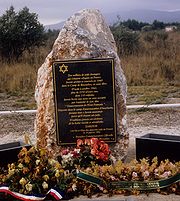 The memorial museum project has its origins in the publication of the list of deported Jews
The memorial museum project has its origins in the publication of the list of deported Jews
and Jews who died in the camp of Rivesaltes, by Serge Klarsfeld in 1978.
Joseph Joffre
Joseph Jacques Césaire Joffre OM was a French general during World War I. He is most known for regrouping the retreating allied armies to defeat the Germans at the strategically decisive First Battle of the Marne in 1914. His popularity led to his nickname Papa Joffre.-Biography:Joffre was born in...
) located on the territory of the commune of Rivesaltes
Rivesaltes
Rivesaltes is a commune in the Pyrénées-Orientales department in southern France.-People:Rivesaltes was the birthplace of Joseph Joffre , general who became prominent in the battles of World War I.-The Rivesaltes memorial museum:...
in Pyrénées-Orientales
Pyrénées-Orientales
Pyrénées-Orientales is a department of southern France adjacent to the northern Spanish frontier and the Mediterranean Sea. It also surrounds the tiny Spanish enclave of Llívia, and thus has two distinct borders with Spain.- History :...
in the South of France
France
The French Republic , The French Republic , The French Republic , (commonly known as France , is a unitary semi-presidential republic in Western Europe with several overseas territories and islands located on other continents and in the Indian, Pacific, and Atlantic oceans. Metropolitan France...
. The camp was also used for interning several civil populations during 1939–2007. The darkest period of the camp was in 1942 when 2,251 Jews
Jews
The Jews , also known as the Jewish people, are a nation and ethnoreligious group originating in the Israelites or Hebrews of the Ancient Near East. The Jewish ethnicity, nationality, and religion are strongly interrelated, as Judaism is the traditional faith of the Jewish nation...
, including 110 children, were transferred from Rivesaltes via the Drancy internment camp
Drancy internment camp
The Drancy internment camp of Paris, France, was used to hold Jews who were later deported to the extermination camps. 65,000 Jews were deported from Drancy, of whom 63,000 were murdered including 6,000 children...
to Auschwitz
Auschwitz concentration camp
Concentration camp Auschwitz was a network of Nazi concentration and extermination camps built and operated by the Third Reich in Polish areas annexed by Nazi Germany during World War II...
, where they were murdered.
The History of Camp Joffre in Rivesaltes
In 1935, the commune of RivesaltesRivesaltes
Rivesaltes is a commune in the Pyrénées-Orientales department in southern France.-People:Rivesaltes was the birthplace of Joseph Joffre , general who became prominent in the battles of World War I.-The Rivesaltes memorial museum:...
, situated on a rail route and 40 km from the Spanish border, was considered a strategic position for the French Army
French Army
The French Army, officially the Armée de Terre , is the land-based and largest component of the French Armed Forces.As of 2010, the army employs 123,100 regulars, 18,350 part-time reservists and 7,700 Legionnaires. All soldiers are professionals, following the suspension of conscription, voted in...
. 5 km from the city of Rivesaltes
Rivesaltes
Rivesaltes is a commune in the Pyrénées-Orientales department in southern France.-People:Rivesaltes was the birthplace of Joseph Joffre , general who became prominent in the battles of World War I.-The Rivesaltes memorial museum:...
, the army
French Army
The French Army, officially the Armée de Terre , is the land-based and largest component of the French Armed Forces.As of 2010, the army employs 123,100 regulars, 18,350 part-time reservists and 7,700 Legionnaires. All soldiers are professionals, following the suspension of conscription, voted in...
occupied 612 hectares between Rivesaltes
Rivesaltes
Rivesaltes is a commune in the Pyrénées-Orientales department in southern France.-People:Rivesaltes was the birthplace of Joseph Joffre , general who became prominent in the battles of World War I.-The Rivesaltes memorial museum:...
and Salses, to construct a camp, originally intended as a military base.
At the same time, southern France became a major haven for Jewish refugees attempting to flee to neutral countries, whether legally or illegally.
Creation of the Camp (1938–1940)

The Spanish Republicans
The "Camp Joffre" military camp was built in 1938, a few miles from PerpignanPerpignan
-Sport:Perpignan is a rugby stronghold: their rugby union side, USA Perpignan, is a regular competitor in the Heineken Cup and seven times champion of the Top 14 , while their rugby league side plays in the engage Super League under the name Catalans Dragons.-Culture:Since 2004, every year in the...
; four-fifths of the camp was situated within the commune of Rivesaltes
Rivesaltes
Rivesaltes is a commune in the Pyrénées-Orientales department in southern France.-People:Rivesaltes was the birthplace of Joseph Joffre , general who became prominent in the battles of World War I.-The Rivesaltes memorial museum:...
and one-fifth within the commune of Salses.
Following the Retirada
Spanish Civil War
The Spanish Civil WarAlso known as The Crusade among Nationalists, the Fourth Carlist War among Carlists, and The Rebellion or Uprising among Republicans. was a major conflict fought in Spain from 17 July 1936 to 1 April 1939...
, the government decided to use Camp Joffre to intern more than 15,000 Catalan refugees. This decision remained in the planning stages, though a small influx of Catalan refugees was brought in (1939).
On the December 10, 1940, the Ministry of Defense set aside 600 acres (2.4 km²) south of the camp, to house individuals expelled from Germany
Germany
Germany , officially the Federal Republic of Germany , is a federal parliamentary republic in Europe. The country consists of 16 states while the capital and largest city is Berlin. Germany covers an area of 357,021 km2 and has a largely temperate seasonal climate...
. The military camp was then run parallel to the civilian camps.
In 1939, at the start of the second world war, the camp became a military transit base and in 1940 a refuge for Spanish refugees
Spanish Civil War
The Spanish Civil WarAlso known as The Crusade among Nationalists, the Fourth Carlist War among Carlists, and The Rebellion or Uprising among Republicans. was a major conflict fought in Spain from 17 July 1936 to 1 April 1939...
fleeing the Franco dictatorship
Francisco Franco
Francisco Franco y Bahamonde was a Spanish general, dictator and head of state of Spain from October 1936 , and de facto regent of the nominally restored Kingdom of Spain from 1947 until his death in November, 1975...
. After the signing of the armistice
Armistice
An armistice is a situation in a war where the warring parties agree to stop fighting. It is not necessarily the end of a war, but may be just a cessation of hostilities while an attempt is made to negotiate a lasting peace...
, France
France
The French Republic , The French Republic , The French Republic , (commonly known as France , is a unitary semi-presidential republic in Western Europe with several overseas territories and islands located on other continents and in the Indian, Pacific, and Atlantic oceans. Metropolitan France...
was split into two. The zone libre, in which the Pyrenees-Orientales
Pyrénées-Orientales
Pyrénées-Orientales is a department of southern France adjacent to the northern Spanish frontier and the Mediterranean Sea. It also surrounds the tiny Spanish enclave of Llívia, and thus has two distinct borders with Spain.- History :...
was included, came under the administration of the Vichy government.
Gradually, the Joffre camp became a place of internment for families of gypsies, Jews
Jews
The Jews , also known as the Jewish people, are a nation and ethnoreligious group originating in the Israelites or Hebrews of the Ancient Near East. The Jewish ethnicity, nationality, and religion are strongly interrelated, as Judaism is the traditional faith of the Jewish nation...
and Spanish refugees
Spanish Civil War
The Spanish Civil WarAlso known as The Crusade among Nationalists, the Fourth Carlist War among Carlists, and The Rebellion or Uprising among Republicans. was a major conflict fought in Spain from 17 July 1936 to 1 April 1939...
. With a capacity of 8000, it was not long before the camp was overcrowded, families were separated, and conditions deteriorated greatly.
Spanish Prisoners and foreign Jews

It was decided that this is a "accommodation center" for families. Initially planned for a maximum of 17,000 "guests", it included 150 large barracks, adding up to a housing capacity of 10,000 individuals.
The particularity of the place was that families were housed in the same camp, but in separate barracks: there were barracks for men, others for women and children. By May 31, 1941, the camp had 6,475 internees from 16 nationalities, more than half from Spain
Spain
Spain , officially the Kingdom of Spain languages]] under the European Charter for Regional or Minority Languages. In each of these, Spain's official name is as follows:;;;;;;), is a country and member state of the European Union located in southwestern Europe on the Iberian Peninsula...
. Jewish refugees from other countries made up more than one-third.
The Special Camp (1942)—the "Drancy of free zone"


Jews
The Jews , also known as the Jewish people, are a nation and ethnoreligious group originating in the Israelites or Hebrews of the Ancient Near East. The Jewish ethnicity, nationality, and religion are strongly interrelated, as Judaism is the traditional faith of the Jewish nation...
in the southern zone. They were brought to the 'Centre national de rassemblement des Israélites' at Rivesaltes
Rivesaltes
Rivesaltes is a commune in the Pyrénées-Orientales department in southern France.-People:Rivesaltes was the birthplace of Joseph Joffre , general who became prominent in the battles of World War I.-The Rivesaltes memorial museum:...
. This "Center" was newly established in the camp, in blocks J (for women and children), F (for men; this block had previously been reserved for workers) and K (reception, screening and sorting). It was planned as a transit camp for a total of 10,000 internees who would be housed there for 15 days before being deported. The 1,176 Jews already in the camp prior to the round-up were included in this group.
Convoys left from Rivesaltes for Drancy
Drancy internment camp
The Drancy internment camp of Paris, France, was used to hold Jews who were later deported to the extermination camps. 65,000 Jews were deported from Drancy, of whom 63,000 were murdered including 6,000 children...
on August 11 (400 people), August 23 (175 people), September 1 (173 people), September 4 (621 people), September 14 (594 people), September 21 (72 people), September 28 (70 people), October (101 people) and October 20 (107 people).
Serge Klarsfeld called the Rivesaltes camp "the Drancy
Drancy internment camp
The Drancy internment camp of Paris, France, was used to hold Jews who were later deported to the extermination camps. 65,000 Jews were deported from Drancy, of whom 63,000 were murdered including 6,000 children...
of the free zone", noting that from September 4 to October 22 it played the same role as the Drancy camp in the occupied zone: a transit camp for deportees whose ultimate destination was the Nazi extermination camps. Rivesaltes was, during that time, the camp where all Jews arrested in the "free zone"
Vichy France
Vichy France, Vichy Regime, or Vichy Government, are common terms used to describe the government of France that collaborated with the Axis powers from July 1940 to August 1944. This government succeeded the Third Republic and preceded the Provisional Government of the French Republic...
were gathered and from which many of them (about 1,700) were sent to Drancy
Drancy internment camp
The Drancy internment camp of Paris, France, was used to hold Jews who were later deported to the extermination camps. 65,000 Jews were deported from Drancy, of whom 63,000 were murdered including 6,000 children...
itself.
In November 1942, as Germany invaded the southern, previously unoccupied zone
Zone
-Places:France* Any of several divisions during the German occupation of France during World War IIGermany* The Zone , a derogatory term for the German Democratic RepublicGreece...
of France, German troops moved into Camp Joffre. Accordingly, the camp was closed as an internment camp on November 25. There were 277 staff members when it closed.
- During those two years, the camp of Rivesaltes housed about 21,000 internees; about 5,714 of them were interned in the "special camp" or transit camp, of whom 2,313 were sent to Drancy and 2,251 were excluded from deportation by the screening committee. 215 internees died in the camp, including 51 children one year old or younger.
The guarded residence center (1944–1946)
The German armyGerman Army
The German Army is the land component of the armed forces of the Federal Republic of Germany. Following the disbanding of the Wehrmacht after World War II, it was re-established in 1955 as the Bundesheer, part of the newly formed West German Bundeswehr along with the Navy and the Air Force...
left Rivesaltes
Rivesaltes
Rivesaltes is a commune in the Pyrénées-Orientales department in southern France.-People:Rivesaltes was the birthplace of Joseph Joffre , general who became prominent in the battles of World War I.-The Rivesaltes memorial museum:...
on August 19, 1944.
While the military in Rivesaltes camp resumed its original purpose, a new "guarded residence center" was established at Rivesaltes (September 12, 1944). Located chiefly in block Q, this center housed people interned under Vichy's "épuration" policy. This new camp had a maximum capacity of 1,080 internees.
The center continued to receive people from other European countries: the Spanish
Spanish people
The Spanish are citizens of the Kingdom of Spain. Within Spain, there are also a number of vigorous nationalisms and regionalisms, reflecting the country's complex history....
, interned for crossing the border illegally, were put to work to secure the center. Then in January and March 1945 several hundreds of Soviet POW, arrived.
The closing of the center was decided upon on December 10, 1945 and completed early in October 1946.
The German prisoners
The military authority transformed the camp into Depot No. 162 for prisoners of war. Housing mostly GermanGermany
Germany , officially the Federal Republic of Germany , is a federal parliamentary republic in Europe. The country consists of 16 states while the capital and largest city is Berlin. Germany covers an area of 357,021 km2 and has a largely temperate seasonal climate...
and Italian
Italy
Italy , officially the Italian Republic languages]] under the European Charter for Regional or Minority Languages. In each of these, Italy's official name is as follows:;;;;;;;;), is a unitary parliamentary republic in South-Central Europe. To the north it borders France, Switzerland, Austria and...
soldiers, this camp counted less than 10 000 prisoners in October 1944, and around 6000 or 7000 men in May 1945. It closed on May 1, 1948.
The prisoners worked extensively in the reconstruction of the Roussillon
Roussillon
Roussillon is one of the historical counties of the former Principality of Catalonia, corresponding roughly to the present-day southern French département of Pyrénées-Orientales...
region. But between May 1945 and 1946, 412 German prisoners of war died in the camp.
La Guerre d'Algérie
Under the stiffening of the French state caused by the Algerian War, the French government planned in 1957 to create an "internment camp" on the site.The Prefect
Prefect
Prefect is a magisterial title of varying definition....
attempted to dissuade them, because the site contained, in addition to a training center mainly populated by North Africans, a Professional Military Training Center particularly for North Africans and young soldiers mobilized for war.
The plan was not carried out in its entirety, but, discreetly, a prison was set up for people convicted of being supporters of the Algerian independence. 527 prisoners entered the center between March 9 and April 18, 1962.
The Harkis
Harkis is the generic term for Muslim Algerians serving as auxiliaries with the French ArmyFrench Army
The French Army, officially the Armée de Terre , is the land-based and largest component of the French Armed Forces.As of 2010, the army employs 123,100 regulars, 18,350 part-time reservists and 7,700 Legionnaires. All soldiers are professionals, following the suspension of conscription, voted in...
, during the Algerian War, 1954–1962.
June 1962, the "1st regiment of Algerian riflemen" was repatriated to the Camp Joffre. They brought with them hundreds of civilians, women and children running away from the new independent Algeria
Algeria
Algeria , officially the People's Democratic Republic of Algeria , also formally referred to as the Democratic and Popular Republic of Algeria, is a country in the Maghreb region of Northwest Africa with Algiers as its capital.In terms of land area, it is the largest country in Africa and the Arab...
. In October 1962, about 8000 Harkis were staying at the transit and reclassification camp of Rivesaltes (including those from the camp of Larzac
Larzac
The Causse du Larzac is a limestone karst plateau in the south of the Massif Central, France, situated between Millau and Lodève...
and Bourg-Lastic
Bourg-Lastic
Bourg-Lastic is a commune in the Puy-de-Dôme department in Auvergne in central France.-References:*...
). In all, according to the calculations of Abderahmen Moumen, about 20 000 people passed through and piled up in the camp from 1962 to 1964. The stay varied according to the families a few days for some, years for others.
The families considered "irretrievable" — a term used by administrative employees at the time — were sent at the end of the year 1964 to the camp / host city of Saint-Maurice-l'Ardoise in the Gard
Gard
Gard is a département located in southern France in the Languedoc-Roussillon region.The department is named after the River Gard, although the formerly Occitan name of the River Gard, Gardon, has been replacing the traditional French name in recent decades, even among French speakers.- History...
(until 1975). A "civil village" hosted several hundred more families (who had employment but no housing) in the Rivesaltes camp during the 1960s. In 1963, a forestry village was also created in Rivesaltes for about 25 families of former auxiliaries (about a hundred people). The next decade saw the bulk of this population moved to the HLM
HLM
HLM , French for "housing at moderated rents" or "rent-controlled housing", is a form of subsidised housing in France. There are approximately four million such residences, housing an estimated 12 million people — nearly one-fifth of the population of France...
of Rearte, built in the city of Rivesaltes
Rivesaltes
Rivesaltes is a commune in the Pyrénées-Orientales department in southern France.-People:Rivesaltes was the birthplace of Joseph Joffre , general who became prominent in the battles of World War I.-The Rivesaltes memorial museum:...
to finalize the situation of these families. The last residents lef the camp in February 1977.
The Colonial auxiliaries
Other French Colonial ForcesFrench Colonial Forces
The French Colonial Forces , commonly called La Coloniale, was a general designation for the military forces that garrisoned in the French colonial empire from the late 17th century until 1960. They were recruited from mainland France or from the French settler and indigenous populations of the...
, Auxiliaries
Auxiliaries
An auxiliary force is a group affiliated with, but not part of, a military or police organization. In some cases, auxiliaries are armed forces operating in the same manner as regular soldiers...
from Africa
Africa
Africa is the world's second largest and second most populous continent, after Asia. At about 30.2 million km² including adjacent islands, it covers 6% of the Earth's total surface area and 20.4% of the total land area...
and French Indochina
French Indochina
French Indochina was part of the French colonial empire in southeast Asia. A federation of the three Vietnamese regions, Tonkin , Annam , and Cochinchina , as well as Cambodia, was formed in 1887....
came, accompanied by civilians, with the decolonization of the French colonial empire
French colonial empire
The French colonial empire was the set of territories outside Europe that were under French rule primarily from the 17th century to the late 1960s. In the 19th and 20th centuries, the colonial empire of France was the second-largest in the world behind the British Empire. The French colonial empire...
: from 1964 to 1966 about 600 Guineans
French Guinea
French Guinea was a French colonial possession in West Africa. Its borders, while changed over time, were in 1958 those of the independent nation of Guinea....
arrived, and other former soldiers and their families coming from French Indochina
French Indochina
French Indochina was part of the French colonial empire in southeast Asia. A federation of the three Vietnamese regions, Tonkin , Annam , and Cochinchina , as well as Cambodia, was formed in 1887....
.
The Immigration detention center (1986–2007)
Created in 1986, the administrative detention centerImmigration detention
Immigration detention is the policy of holding individuals suspected of visa violations, illegal entry or unauthorised arrival, and those subject to deportation and removal in detention until a decision is made by immigration authorities to grant a visa and release them into the community, or to...
was first made for Spanish nationals who had entered French territory illegally
Illegal immigration
Illegal immigration is the migration into a nation in violation of the immigration laws of that jurisdiction. Illegal immigration raises many political, economical and social issues and has become a source of major controversy in developed countries and the more successful developing countries.In...
.
With more than a thousand arrested on French soil in 1994, it was one of the largest detention centers in France
France
The French Republic , The French Republic , The French Republic , (commonly known as France , is a unitary semi-presidential republic in Western Europe with several overseas territories and islands located on other continents and in the Indian, Pacific, and Atlantic oceans. Metropolitan France...
.
In 2007, the authorities moved the center.
The Rivesaltes memorial museum

The Holocaust
The Holocaust , also known as the Shoah , was the genocide of approximately six million European Jews and millions of others during World War II, a programme of systematic state-sponsored murder by Nazi...
and Jews who died in the camp of Rivesaltes, by Serge Klarsfeld in 1978.
- In 1993, Serge Klarsfeld published "The transfer of Jews from the camp of Rivesaltes and the Montpellier area towards the center of DrancyDrancy internment campThe Drancy internment camp of Paris, France, was used to hold Jews who were later deported to the extermination camps. 65,000 Jews were deported from Drancy, of whom 63,000 were murdered including 6,000 children...
for deportationDeportationDeportation means the expulsion of a person or group of people from a place or country. Today it often refers to the expulsion of foreign nationals whereas the expulsion of nationals is called banishment, exile, or penal transportation...
on August 10, 1942."
- On January 16, 1994, Serge Klarsfeld's association "Sons and daughters of deported Jews from France" erected a monument to the memory of 2313 Jews deported from the Rivesaltes camp to Auschwitz.
- December 2, 1995, installation of a monument in the memory of the Harkis.
- In 1997, the collective petition "To the living memory of the camp of Rivesaltes" was signed by Simone VeilSimone VeilSimone Veil, DBE is a French lawyer and politician who served as Minister of Health under Valéry Giscard d'Estaing, President of the European Parliament and member of the Constitutional Council of France....
, Claude SimonClaude SimonClaude Simon was a French novelist and the 1985 Nobel Laureate in Literature. He was born in Antananarivo, Madagascar, and died in Paris, France....
, Edgar MorinEdgar MorinEdgar Morin is a French philosopher and sociologist born Edgar Nahoum in Paris on July 8, 1921. He is of Judeo-Spanish origin. He is known for the transdisciplinarity of his works.- Biography :...
and many citizens to protest against threats of destruction of the camp.
- In 1998, Christian BourquinChristian BourquinChristian Bourquin is a French politician, member of the Socialist Party. He has been the president of the General Council of the Pyrénées-Orientales since 1998.-Elected office:...
, new president of the General Council of the Pyrénées-OrientalesGeneral Council of the Pyrénées-OrientalesThe General Council of the Pyrénées-Orientales is the assembly elected for 6 years by the 31 Cantons of the Pyrénées-Orientales and its executive...
opposed the destruction of the site and started public consultations on the project.
- October 30, 1999, a steleSteleA stele , also stela , is a stone or wooden slab, generally taller than it is wide, erected for funerals or commemorative purposes, most usually decorated with the names and titles of the deceased or living — inscribed, carved in relief , or painted onto the slab...
was erected in memory of the Spanish RepublicansSpanish Civil WarThe Spanish Civil WarAlso known as The Crusade among Nationalists, the Fourth Carlist War among Carlists, and The Rebellion or Uprising among Republicans. was a major conflict fought in Spain from 17 July 1936 to 1 April 1939...
.
- 2000, inscription in the supplementary inventory of Monument historiqueMonument historiqueA monument historique is a National Heritage Site of France. It also refers to a state procedure in France by which national heritage protection is extended to a building or a specific part of a building, a collection of buildings, or gardens, bridges, and other structures, because of their...
by the Ministry of Culture.
- 2005 at the French Heritage DayHeritage DayHeritage Day may refer to:* Heritage Day in Canada on:** the first Monday in August in Alberta, or** the third Monday in February in Kingston, Ontario.* Heritage Day in South Africa on September 24* European Heritage Days...
, part of the camp was opened for the first time to the public. Rudy Ricciotti, won the architectural competition.
- Robert BadinterRobert BadinterRobert Badinter is a high-profile French criminal lawyer, university professor and politician mainly known for his struggle against the death penalty, the abolition of which he successfully sponsored in Parliament in 1981...
agreed to sponsor the project.
- November 2005, the General CouncilGeneral Council of the Pyrénées-OrientalesThe General Council of the Pyrénées-Orientales is the assembly elected for 6 years by the 31 Cantons of the Pyrénées-Orientales and its executive...
acquired the F block, about 42 hectares.
- January 21, 2009, deposit of the construction permitConstruction permitA construction permit or building permit is a permit required in most jurisdictions for new construction, or adding on to pre-existing structures, and in some cases for major renovations. Generally, the new construction must be inspected during construction and after completion to ensure compliance...
by the architect Rudy Ricciotti, work should start in 2010 and take two years.

